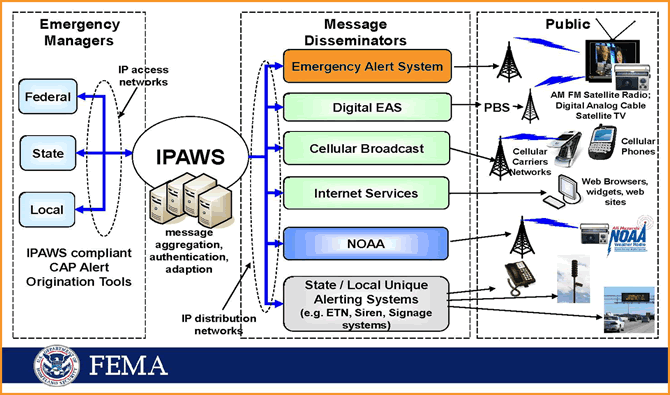The Integrated Public Alert and Warning System
(IPAWS) is the nation's next-generation infrastructure
of alert and warning networks. Falling primarily
within the auspices of the Federal Emergency Management
Agency (FEMA, www.fema.gov),
IPAWS will expand upon the existing radio and TV
Emergency Alert System (EAS) by providing one message
over more media to more people before, during and
after a disaster. The roll-out of IPAWS is intertwined
with the FCC's efforts to create a next-generation
EAS, and broadcasters can expect to see progress
in both areas in 2010.
An overall block diagram of IPAWS is shown below.
Some of the specific goals for IPAWS include the
following:
- Diversify and modernize the EAS;
- Create an interoperability frameword by establishing
or adopting standards such as the Common Alerting
Protocol (CAP; see the March
16, 2009 issue of TV TechCheck for
additional information on CAP);
- Enable alert and warning to those with disabillties
and to those without an udnerstanding of the English
language;
- Provide the President, federal, state, territorial,
tribal and local emergency managers access to
more communication pathways to ensure alerts and
warnings reach the maximum number of Americans
over as many pathways as possible;
- Partner with the National Oceanic and Atmospheric
Administration (NOAA, www.noaa.gov) to enable
seamless integration of message transmission through
national networks.

Under the FCC's current rules for EAS, there are
three important changes coming which are directly
tied to the development of IPAWS and will impact
broadcasters. These changes were established in
the FCC's 2007 Second Report and Order and Further
Notice of Proposed Rulemaking on Next-Generation
EAS (EB Docket 04-296; a copy of this document is
available on the FCC's Web page at http://hraunfoss.fcc.gov/edocs_public/attachmatch/FCC-07-109A1.pdf).
Two of these changes are tied to FEMA's "adoption"
of the CAP standard which has been developed specifically
for IPAWS - 180 days after FEMA adopts CAP, broadcasters
will be required to do the following:
- accept an alert message using a common EAS messaging
protocol (namely, CAP);
- transmit state and local EAS alerts that are
originated by governors or their designees, provided
that the state has a Commission-approved EAS state
plan that provides for delivery of such alerts.
In 2009, FEMA indicated that four specific tasks
need to be completed before CAP will be adopted,
and anticipate that such adoption will occur in
the third quarter of 2010:
1) Establish conformance lab and begin testing
- this task involves certifying that the EAS
equipment used by broadcasters conforms to the CAP
standard. In September of this year, FEMA selected
Eastern Kentucky University as the facility which
will conduct these tests. A number of EAS equipment
manufacturers are already selling equipment that
incorporates CAP features (but this equipment has
not yet been conformance tested) including SAGE
Alerting Systems (SAGE Digital Endec, www.sagealertingsystems.com/products.htm),
Digital Alert Systems (DASDEC,
www.digitalalertsystems.com/DASDEC_intro.htm),
and Trilithic (EasyCast Radio, www.trilithic.com/Emergency%20Alert%20Systems/Products/EASyCAST%20Radio/2011237102.html).
2) Develop CAP-to-EAS translation guide
- a standard way for translating the CAP-formatted
altering messages into the Specific Area Message
Encoding (SAME) format currently used for EAS messages
needs to be developed. One reason this is important
is to ensure that CAP messages are rendered using
SAME so that duplicate messages can be detected.
This means that for a given CAP message, all EAS
encoders must emit the exact same CFR 47 Part 11
"ZCZC" string. The EAS-CAP Industry Group (ECIG,
www.eas-cap.org),
a coalition of EAS equipment, software and service
providers, developed an "EAS CAP Profile Recommendation"
in 2008 which includes a section on CAP-to-EAS translation
(this document is available online at www.eas-cap.org/Recommendation%20EAS-CAP-0.1.pdf).
There are some CAP-to-EAS converters available (but
this equipment has not yet been conformance tested)
from EAS equipment vendors including TFT, Inc. (EAS
2008 CAP-to-EAS converter, www.tftinc.com/products/datasheets/EAS0613-Model%202008-Data%20Sheet-V1-4%202007-07-12.pdf),
Warning Systems, Inc. (AdaptAlert EAS Activation
System, www.warningsystems.com/products_activation_systems.htm),
and Gorman-Redlich (CAP-to-EAS decoder system, www.gorman-redlich.com/CAP%20TO%20EAS%20decoder.htm.
3) Demonstrate delivery of federal message in
CAP format to a PEP station- this is to ensure
that prior to adoption of CAP that a method for
delivery of a CAP formatted alert message to a primary
entry point (PEP) station has been tested; and,
4) Propose and start OASIS process on IPAWS
CAP security profile - this security profile
task pertains to the authentication and verification
of entities entitled to issue emergency alerts using
IPAWS and CAP-formatted messages.
The third change resulting from the 2007 Second
R&O is that EAS participants must adopt "next-generation
EAS delivery systems" no later than 180 days after
FEMA publicly releases standards for those systems.
To date there has been little discussion on next-generation
EAS delivery systems, but in 2010 it is expected
that more details will emerge.
For additional information visit FEMA's IPAWS Web
page at www.fema.gov/emergency/ipaws.


